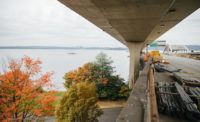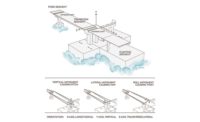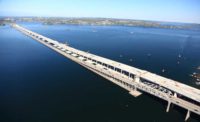For the first time ever, according to Sound Transit officials, light rail track is being installed on a floating bridge—the Interstate 90 Homer M. Hadley Memorial Bridge connecting Seattle to Bellevue as part of a $3.7-billion East Link Extension. Getting side-by-side 1-mile-long fixed rail onto a bridge moving in multiple planes not only required years of testing, but also a fresh approach to construction.
Solutions included a lighter-weight track system, reducing the risk of electrical current going astray and a first-ever land-to-bridge connection.
“It has gone pretty dang well,” says John Sleavin, Sound Transit deputy executive director.
First, crews with a joint venture of Kiewit and Hoffman retrofitted the bridge with post-tensioning and steel reinforcement. “Altogether, this created a very complex geometrical exercise to ensure the structural retrofit, anchors, bearing plates and bridges all lined up,” says Sepehr Sobhani, Sound Transit principal construction manager.
Running 300-ton trains across the accordion-style joints required eight “track bridges” that include a 43-ft curved platform that can move in such a way to keep tracks safe, akin to a three-legged stool where the tracks rest on a platform that has pivoting bearings connected to a hinge. Items sitting on three points always find a plane, no matter which direction the floating bridge rotates and pushes. The connections self-level to support the track at the joint in a continuous alignment.
“The track bridges had to be correlated with the movements of the floating bridge relative to the transition spans to make sure each movement of the bridge is accommodated by the track bridges,” Sobhani says, “which ultimately prevents the movements to transfer undue stress into the rail.”
Crews use 9,000 light concrete blocks to act as rail ties. The setup requires a plastic drip cap and a rubberized layer to prevent electricity from coming off the block into the bridge. Because crews couldn’t drill into the bridge, they used a special epoxy, Dex-G, to attach the units to the bridge deck.
Sound Transit worked with the University of Washington to explore how the epoxy reacted and then tested it in the contractor’s yard to practice putting on the blocks, controlling the Dex-G flow. “There was a lot of process that went in advance of even getting out there because this is a unique construction method,” Sleavin says. “We spent a lot of time with the contractor and that helped us negotiate the price and understand the real hours of work it would take to put this stuff on.”
Surveying on a floating bridge provided challenges, coupled with tight tolerance by using precast plinths that “didn’t leave much room for error,” Sobhani says. Crews surveyed off bridge points, not a satellite. The bridge includes a cross-slope for drainage, but since the precast pieces are flat, crews needed to prep the deck to create flat spots.
Installation of the 9,000 blocks started on May 1. All blocks will be staged on the bridge by the end of September to properly ballast the weight of the bridge before winter. Sleavin expects to continue attaching blocks during stretches of good weather in the winter before completion in late summer 2020.
The bridge contract’s civil work is scheduled to wrap by November 2020 and the East Link project will test trains in 2022 for service in 2023.









Post a comment to this article
Report Abusive Comment